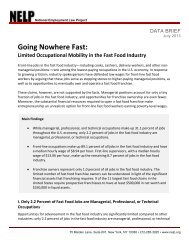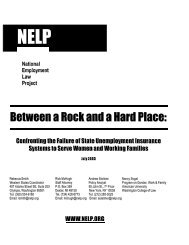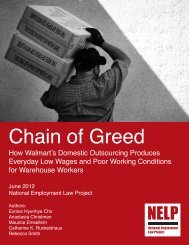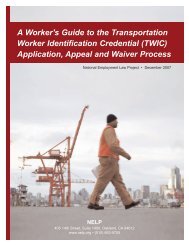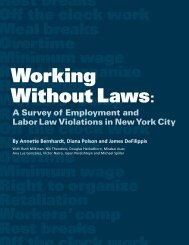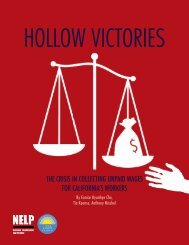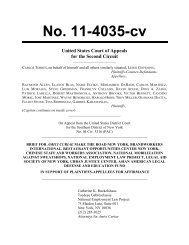Rebuilding Lives. Strengthening Communities.
Rebuilding Lives. Strengthening Communities.
Rebuilding Lives. Strengthening Communities.
Create successful ePaper yourself
Turn your PDF publications into a flip-book with our unique Google optimized e-Paper software.
Introduction<br />
The Reality of Reentry<br />
Every year, the United States sets two prison records—one<br />
we talk about and one we don’t.<br />
Most Americans are quite familiar with our penchant for<br />
putting people into prison. The number of individuals<br />
incarcerated in state and federal correctional institutions has<br />
risen exponentially in the past three decades. In 1980,<br />
there were just over 300,000 people in state and federal<br />
prisons; in 2003, there were nearly 1.4 million people. 1 The<br />
total now exceeds 2.2 million when you combine state and<br />
federal prisons with local jails and other types of confinement.<br />
2 According to the federal Bureau of Justice Statistics,<br />
about 5.6 million adults have served time in state or federal<br />
prison. 3 If this current rate remains unchanged, nearly<br />
one in 15 persons born in 2001 will be imprisoned during<br />
his or her lifetime. 4<br />
But most Americans have typically paid little or no attention<br />
to people coming back from prison. 5 At least 95 percent of<br />
all state prisoners will be released at some point. 6 This year,<br />
our country’s prisons will release nearly 650,000 individuals,<br />
an increase from 170,000 in 1980. 7 This number does not<br />
even include the millions who will finish up jail terms. 8<br />
And they all go in and come out faster than most Americans<br />
realize; the average felony sentence is approximately three<br />
years. 9 The use of probation and parole has exploded to<br />
correspond with these statistics; more than 4.1 million individuals<br />
were on probation and another 765,000 were on<br />
parole at the end of 2004—almost a three percent increase<br />
in just one year. 10<br />
Following national trends, Illinois has seen its prison population<br />
soar in the last 30 years. Between 1970 and 2003,<br />
the Illinois prison population increased by more than 500<br />
percent, from 7,326 to 43,418 prisoners. 11 To keep up with<br />
this growth, the state built an average of one new prison<br />
every year between 1980 and 2000. 12 Yet Illinois prisons<br />
are more overcrowded today than they were in 1980; more<br />
than 44,000 prisoners are housed in facilities designed for<br />
32,000. 13 Illinois currently has 27 correctional facilities,<br />
seven work camps, two boot camps, and eight adult transitional<br />
centers operating throughout the state and employs<br />
14,000 staff to oversee the secure detainment of the state’s<br />
convicted prisoners. 14<br />
Meanwhile, Illinois has seen its prison exits rise as well.<br />
Within just a few years, from 2000 to 2003, the number of<br />
people released from Illinois state prisons jumped from<br />
28,876 to 35,372—an increase of more than 22 percent. 15<br />
Approximately 53 percent of prisoners (15,488 individuals)<br />
released from all Illinois prisons in 2001 returned to the<br />
City of Chicago alone. 16 Based on current estimates, more<br />
than 21,000 will have settled within the city limits in<br />
2005. 17 As the Chicago Tribune recently pointed out, that is<br />
enough “to fill the United Center, about 10 city bus loads<br />
rolling in each week.” 18<br />
Add up all the people under correctional supervision in<br />
Illinois—those behind bars, on probation, or on parole—<br />
and the figure would surpass 244,000. 19 If they were all<br />
placed in one location, it would be the second largest city in<br />
the state. 20<br />
MAYORAL POLICY CAUCUS ON PRISONER REENTRY<br />
3





